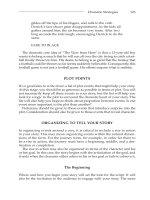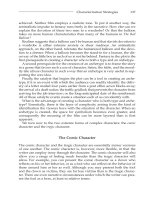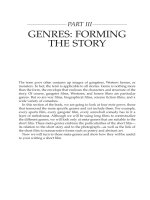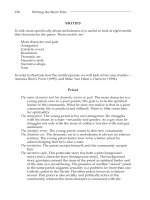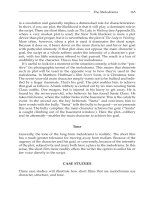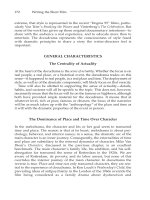Tài liệu Writing the short film 3th - Part 22 pptx
Bạn đang xem bản rút gọn của tài liệu. Xem và tải ngay bản đầy đủ của tài liệu tại đây (135.48 KB, 7 trang )
achieved. Neither film employs a realistic tone. To put it another way, the
antirealistic impulse to fantasy runs freely in the narrative. How else can we
explain the devotion of these two men to a wardrobe? Or that the balloon
takes on more human characteristics than many of the humans in The Red
Balloon?
Realism suggests that a balloon can’t be human and that slavish devotion to
a wardrobe is either extreme anxiety or sheer madness. An antirealistic
approach, on the other hand, tolerates the humanized balloon and the devo-
tion to a dresser. When a balloon becomes the stand-in for a human, the dis-
covery of the little boy in each of us is not far behind. Fantasy in the plot is the
first prerequisite in creating a character who is both a type and an archetype.
A second prerequisite for the creation of an archetype is to frame the story
in a genre that favors such a use of character. Satire, the fable, and the moral-
ity tale all use character in such a way that an archetype is very useful in sup-
porting the core idea.
Finally, the catalyst that begins the plot can be a tool in creating an arche-
type, if it is an event with which the audience can readily identify: the deliv-
ery of a letter mailed four years earlier from a post office seven blocks away;
the arrival of a draft notice; the traffic gridlock that prevents the character from
arriving for the job interview; or the long-anticipated date of the semiformal.
All of these catalytic events create a situation each of us can identify with.
What is the advantage of creating a character who is both type and arche-
type? Essentially, there is the layer of complexity arising from the kind of
identification the viewers have with the situation of the character. When an
archetype is created, the space for symbolism becomes even greater, and
consequently the meaning of the film can be more layered than is first
apparent.
We turn now to the two extreme forms of complex characters: the comic
character and the tragic character.
The Comic Character
The comic character and the tragic character are essentially mirror versions
of one another. The comic character is, however, more flexible, in that the
writer can employ irony through the character. The comic character will also
allow you a range of feeling much broader than the tragic character will
allow. For example, you can present the comic character as a clown who
reflects on his or her behavior, or as a fool who can reflect on the behavior of
those around him or her as well. Although you may present both the fool
and the clown as victims, they are far less victims than is the tragic charac-
ter. There are even narrative circumstances under which the writer can pres-
ent the fool as a hero, at least in relative terms.
Characterization Strategies 137
Ch11.qxd 9/27/04 6:08 PM Page 137
The comic character also has potential for a measure of charisma or
appeal, because he or she tends to stand apart from peers, whether as a result
of their scorn or by the character’s choice.
Finally, the benefits of humor in the narrative accrue more readily when
the main character is a comic character. The result may be charm, or it may
be biting satire. In either case, the comic character tends to energize the nar-
rative in a variety of positive ways.
The Tragic Character
The tragic character tends to be presented as a victim of the narrative. In
fables, morality tales, and satire, as well as other types of stories, it is useful
to have a tragic main character.
The challenge for the writer, however, is to show the main character strug-
gling to not be a victim. Without that struggle, the narrative is flattened. It is
also useful to overdevelop the narrative, so that the odds against the main
character seem overwhelming. When the plot proceeds like an avalanche,
we will have some empathy for the main character as he faces the inevitable.
Finally, the tragic character needn’t be sacrificed in vain. To “redeem” that
sacrifice, you need a witness, a secondary character in the narrative, some-
one who will proceed with life differently after having observed the main
character’s struggle—a person, in other words, who absorbs the lesson of the
narrative. When the main character is a victim, we subtly shift our allegiance
to the witness, thus surviving for another day.
EXERCISE 19
1. List 10 objects you own that are meaningful to you, objects you
would not want to give up. Characterize these objects briefly—for
instance, my grandfather’s jackknife, the piece of blue glass I
found at Jones Beach, and so on. Choose the five most important.
Write any changes in the descriptions you would like.
2. Pick a fairy tale and picture the main character. Describe his or her
life. Imagine the possessions that might be meaningful to him or
her. List five of these in the same way, as in Number 1. For
instance, in “Little Red Riding Hood” you might list the following:
the red-hooded cape my mother made for me; my new patent
leather shoes; the little clock my grandmother gave me for my
birthday; my jump rope; my collection of stones from the forest.
3. Write a short paragraph in which your character is alone in a
room, then perhaps outside, and in some way handles, wears, or
138 Writing the Short Film
Ch11.qxd 9/27/04 6:08 PM Page 138
uses each of the objects. Remember to use present tense, as in all
scriptwriting, and be sure to describe only what you can see and
hear. Do not include thoughts or feelings—these must be expressed
in the handling of the objects. Remember also that character can be
fleshed out by habitual behavior; here is a chance to show us how
your protagonist behaves when alone.
4. After you’ve finished the last two steps of the exercise, read them
aloud and try to answer the following questions from the evidence
on the page: Does your character enjoy life? Is your character
active physically? Is your character reflective? Is your character
sensuous? Is your character sad or uneasy? Is your character eager
to find new ways of doing things?
The goal here is to understand as much as possible about your character
before you begin to write your script.
NOTES
1. E. M. Forster, Aspects of the Novel (New York: Harcourt Brace, 1956).
2. Aristotle, Poetics, ed. Francis Fergusson, trans. and introduction by S. H. Butcher
(New York: Hill and Wang, 1961), 62.
3. Konstantin Stanislavsky, Creating a Role, ed. Hermine I. Popper (New York:
Routledge, Chapman & Hall, 1961).
4. Elia Kazan, notebook on directing A Streetcar Named Desire. See also Elia Kazan, A
Life (New York: Knopf, 1988).
5. As a thoroughly despicable main character, he needs all the empathy he can get if
we are to in any way identify with him, whether as a young person, a rebel, or a
victim.
Characterization Strategies 139
Ch11.qxd 9/27/04 6:08 PM Page 139
Ch11.qxd 9/27/04 6:08 PM Page 140
12
MORE ON DIALOGUE
STRATEGIES
Like every other dimension of the short film, dialogue has to be exercised
with economy and purposefulness. There is no time for lengthy speeches or
excessive exposition. Perhaps the most useful strategy with dialogue is to
view it as another opportunity to further the emotional drive of your screen
story. In this sense, dialogue should be as animated, intentional, and active
as the visual dimension of your story. Consider dialogue as much a part of
the action of the script as the visualized actions.
The underlying premise here is that language can create a sense of activ-
ity and intensity of the kind that one usually associates exclusively with
visual action. Dialogue and visuals must be partners in the short script; our
goal in this chapter is to show you how to make them partners. Before we do
so, however, we will begin with a warning: don’t use too much dialogue. This
may seem to contradict the previous assertion, but a few illustrations will
clarify and contextualize the caution.
What if a film were made up entirely of dialogue? It could work, but the
energy, characterization, maturation, and plotting would all come from the
same source: the dialogue. Unless that dialogue were tremendously vital, we
in the audience might not engage with the screen story as readily as we
would if there were visual variety. We also would tire or tune out; sound and
dialogue overload would take place, in part because the viewer needs more
time to interpret sound than visuals. The danger here is that the screen story
will bore or tire the viewer.
Even in a less extreme case, in which dialogue did not exclude other ele-
ments but was simply excessive, there would still be an imbalance—too
much aural stimulation and not enough visual.
The writer needs to find a proper balance between dialogue and visuals in
order to provide viewers with the variety they need to interpret what is
being said and seen and be stimulated by both.
141
Ch12.qxd 9/27/04 6:09 PM Page 141

